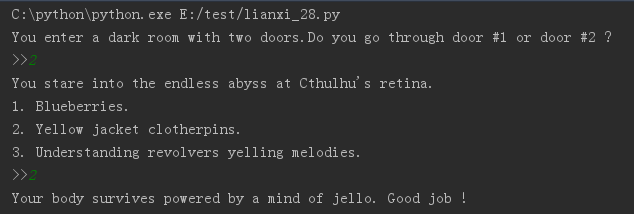习题28:作出决定
发布时间:2017-11-15 15:51:30编辑:Run阅读(6284)
多实践,多练习
练习代码如下:
# coding: utf-8
__author__ = 'www.py3study.com'
print("You enter a dark room with two doors.Do you go through door #1 or door #2 ?")
door = input(">>")
if door == '1':
print("There's a giant bear here eating a cheese cake. What do you do ?")
print("1. Take the cake.")
print("2. Scream at the bear.")
bear = input(">>")
if bear == '1':
print("The bear eats your face off. Good job!")
elif bear == '2':
print("The bear eats your legs off. Good job!")
else:
print("Well, doing {} is probably better. Bear runs away.".format(bear))
elif door == '2':
print("You stare into the endless abyss at Cthulhu's retina.")
print("1. Blueberries.")
print("2. Yellow jacket clotherpins.")
print("3. Understanding revolvers yelling melodies.")
insanity = input(">>")
if insanity == '1' or insanity == '2':
print("Your body survives powered by a mind of jello. Good job !")
else:
print("The insanity rots your eyes into a pool of muck. Good job !")
else:
print("You stumble around and fall on a knife and die. Good job !")
这里的重点是你可以在"if语句"内部再放一个“if语句”,这是一个很强大的功能,可以用来创建嵌套(nested)的决定,其中的一个分支将引向另一个分支的子分支
应该看到的结果

上面的列子有更多的选择,这里就不演示了
常见问题
可以用多个if/else来取代elif吗?
有时候可以,不过这也取决于if/else是怎么样写的。而且这样一来python就需要去检测每一处if/else,而不是像if/elif/else一样,只需要检查到第一个True就可以停下来了
怎么判断一个数字处于某个值域中?
两个办法:经典语法是使用1<x<10,或者用x in range(1,10)也可以
怎样用if/elif/else区块实现四个以上的条件判断?
简单,多写几个elif区块就可以了
上一篇: 习题27:if和else
下一篇: 习题29:循环和列表
- openvpn linux客户端使用
51693
- H3C基本命令大全
51348
- openvpn windows客户端使用
41786
- H3C IRF原理及 配置
38558
- Python exit()函数
33031
- openvpn mac客户端使用
30057
- python全系列官方中文文档
28719
- python 获取网卡实时流量
23709
- 1.常用turtle功能函数
23632
- python 获取Linux和Windows硬件信息
21996
- Python搭建一个RAG系统(分片/检索/召回/重排序/生成)
2194°
- Browser-use:智能浏览器自动化(Web-Agent)
2888°
- 使用 LangChain 实现本地 Agent
2403°
- 使用 LangChain 构建本地 RAG 应用
2352°
- 使用LLaMA-Factory微调大模型的function calling能力
2920°
- 复现一个简单Agent系统
2355°
- LLaMA Factory-Lora微调实现声控语音多轮问答对话-1
3153°
- LLaMA Factory微调后的模型合并导出和部署-4
5183°
- LLaMA Factory微调模型的各种参数怎么设置-3
5006°
- LLaMA Factory构建高质量数据集-2
3580°
- 姓名:Run
- 职业:谜
- 邮箱:383697894@qq.com
- 定位:上海 · 松江
